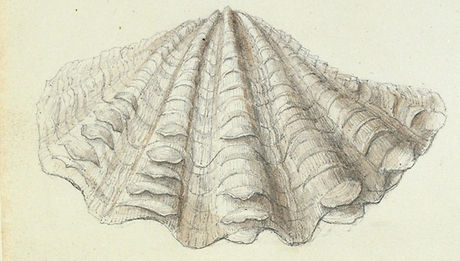
Anna Atkins
Photographs of British Algae: Cyanotype Impressions
Cover of the copy at the Rijksmuseum

Anna Atkins in 1861
1 Larry J. Schaaf, Sun Gardens: Cyanotypes of Anna Atkins, p. 38.
2 Mary Waren Marien, Photography: A Cultural History, 3rd edition, p.34.
Anna Atkins (1799-1871)
Text by Pai Dekkers
Recently, a post on Instagram which I tagged with #annaatkins triggered a response from one of Anna Atkins’ descendants. This surprised me since I never expected to come into contact with her kin when we first started the project. Suddenly, Mrs. Atkins felt very close. They still call her ‘Anna’, making me realise she is part of a family. Somehow I have overlooked this, focussing on the photographic legacy she left behind. Her descendants still live close to where Anna Children was born on 16 March 1799 in Tonbridge, Kent. In 1825 she married John Pelly Atkins and moved to Halstead Place, Sevenoaks. Hopefully, sometime soon we will be able to visit Tonbridge as well as Sevenoaks, where she worked and lived until she died on 9 June 1871.
Larry J. Schaaf offers a complete overview of Mrs. Atkins’ life and work in Sun Gardens: Cyanotypes by Anna Atkins. Therefore, I will try to briefly describe my own understanding of her life and work, but will sometimes refer to Schaaf's writings. When researching Mrs. Atkins, one of the first things you will find is that she is considered to be the first woman to create a photograph. The other female photographer who is considered as being the first is William Henry Fox Talbot’s wife Constance Fox Talbot. Therefore, in my opinion it hardly matters who actually was the first. Fact is, the invention of photography cannot be reduced to a single moment in time, person or process. It has been a long experimental way with a lot of contributors, both male and female. However, the first photographically illustrated book may be credited to Mrs. Atkins. The first part of Talbot's commercial book The Pencil of Nature, was published in 1844. Several months earlier, in October 1843 Mrs. Atkins privately published several copies of Photographs of British Algae: Cyanotype Impressions.(1) But the beauty of this book being first is, in my mind, that she produced them in order to offer to her fellow botanical friends as a gift. I do not think she intended to produce the first photo book. Instead, she recognised the qualities of photography in constituting persuasive documentation. Her aim was to overcome the difficulty of making accurate drawings of algae and turned to photography to create beautiful impressions. She combined scientific accuracy with aesthetic sensitivity.(2) Yet, I can only guess at her intentions, but I like to believe she was pursuing her botanical interests and happened to produce the first photographically illustrated book along the way.


Ulva latissima by
Anna Atkins
3 Larry J. Schaaf, Sun Gardens: Cyanotypes of Anna Atkins, p. 44.
What strikes me personally is the upbringing of Mrs. Atkins, since I recognise myself at times. Unfortunately, her mother did not recover from giving birth to her. But this probably explains the close relationship she had with her father, John George Children. As a respected scientist, her father passed along a great appreciation for science.(3) Being a son of a botanist myself, I can perfectly image her father being excited about new discoveries. Here I refer to the obsessive need collect, document and experiment. But perhaps more important is the way scientists perceive the world. There is a constant want for discoveries that drive the scientist. Everything needs to be explored and no stone left unturned. This manner of perceiving the world is highly valuable to me. In particular, trying to gain a better understanding the mechanisms of the world. This is not be confused with reducing everything down to numbers and statistics, but the feeling of contributing to parts of the puzzle that constitute the natural world. I can imagine Mrs. Atkins was encouraged in a similar way, which inspired her to pursue her grand undertakings.

Soon enough Mrs. Atkins’ interest in botany and the natural world in general sparked. This is clearly visible in her ability to make accurate drawings of buildings, trees and seashells. For example, she completed 256 scientific drawings of shells to accompany her fathers' English translation of Lamarck's Genera of Shells.
to be continued...

